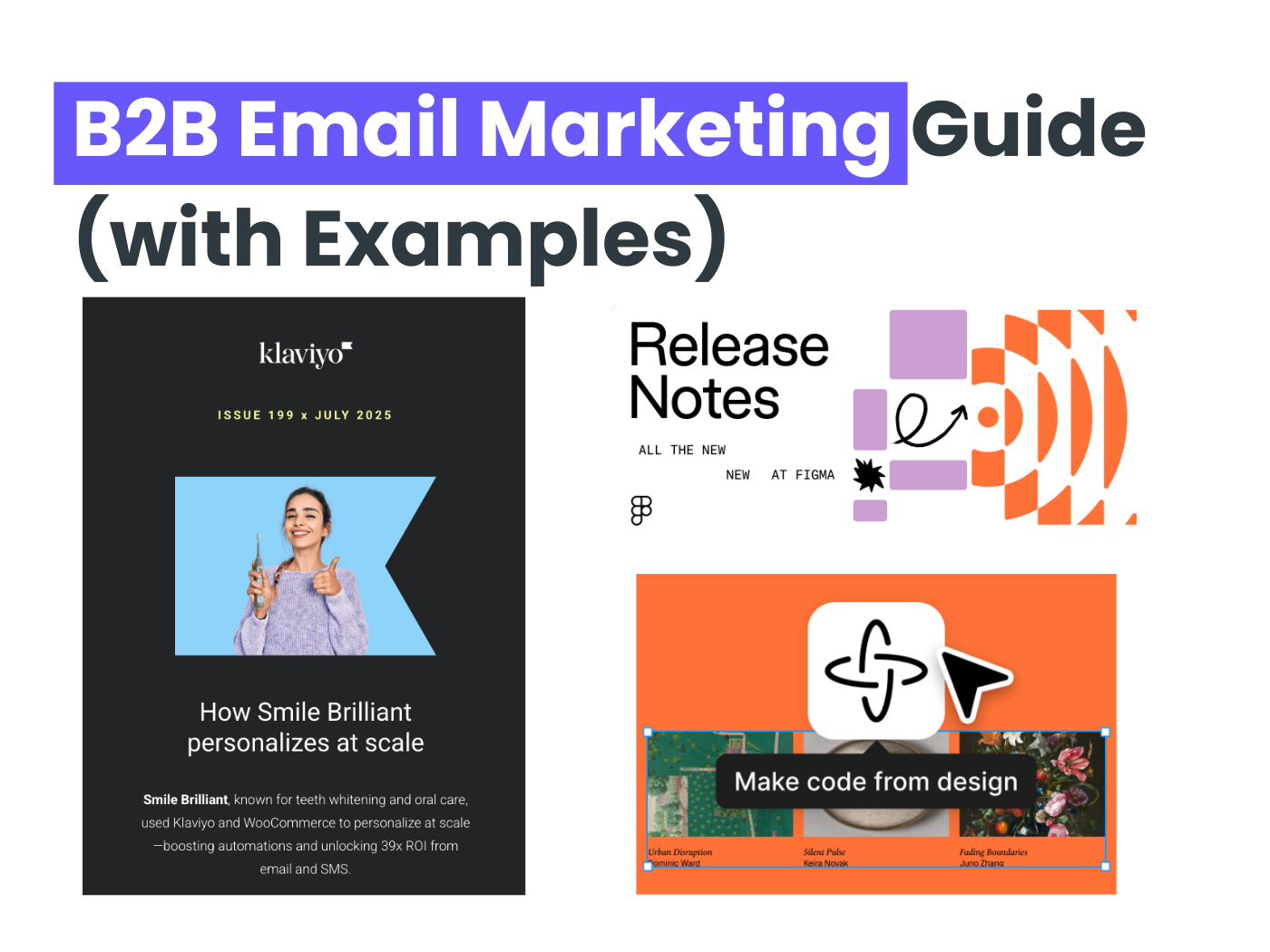When it comes to reaching professional audiences, few channels are as effective—or as essential—as email.
Email is so pivotal that 83 percent of B2B marketers think of email as one of their most important channels.
For B2B companies, email marketing isn’t just a way to share news or promotions; it’s a strategic tool for nurturing leads, building relationships, and driving conversions.
Whether you're a marketer at an agency, a founder of a SaaS company, or creating campaigns for your own brand, having a solid B2B email marketing strategy is crucial.
In this article, we’ll cover what B2B email marketing is, why it matters, and how you can create smart, successful campaigns.
For your marketing inspiration needs or if you want to learn best practices for your B2B brand, look no further than Panoramata.
It has a database of millions of emails from B2B, ecommerce, SaaS and other industries, ensuring you have an endless resource of ideas. You can even track competitors in one place for even more personalized insights.
Sign up today and elevate your email campaigns.
What is B2B Email Marketing?
B2B (business-to-business) email marketing refers to the use of email campaigns to connect with other businesses, rather than individual consumers.
The goals typically revolve around lead generation, relationship building, product education, and sales.
Unlike B2C marketing—where emails are often designed to trigger an immediate purchase—B2B email marketing is more focused on nurturing long-term relationships and providing value over time.
These emails might include:
- Product demos and webinar invites
- Industry reports or whitepapers
- Case studies and success stories
- Customer onboarding flows
- Re-engagement campaigns for inactive leads
Because B2B decision-makers are more rational and research-driven, your email content needs to educate, solve problems, and speak to business pain points.
Why Do You Need a B2B Email Strategy?
It’s not enough to send emails when you remember. Without a clear strategy, your messages can get lost, ignored, or worse—unsubscribed from.
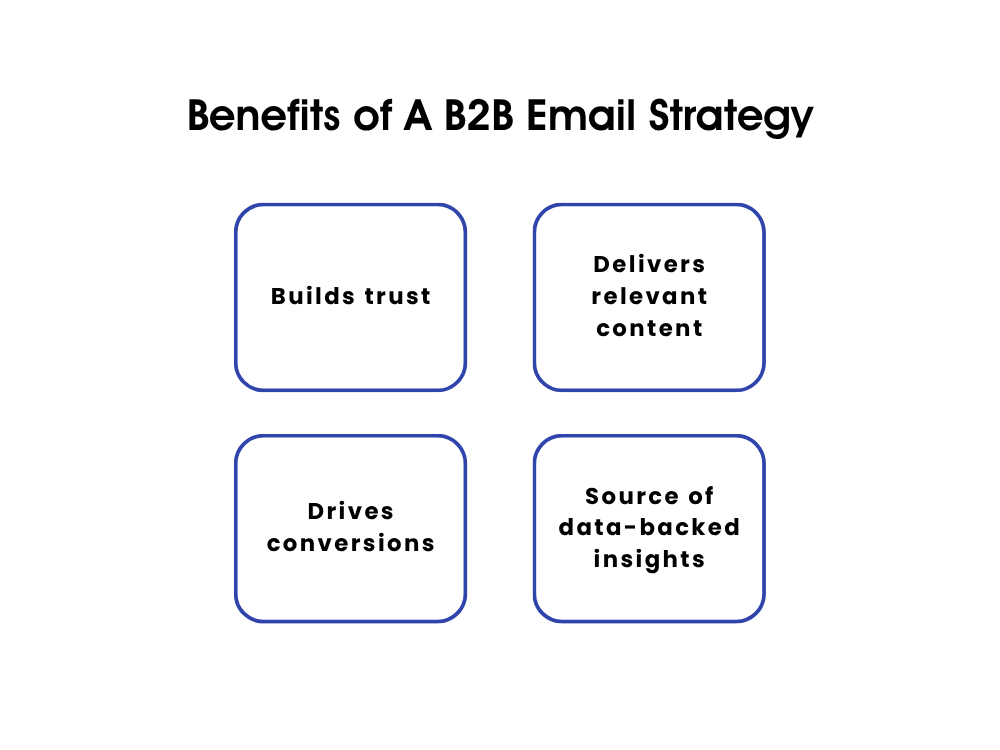
Here’s why a dedicated B2B email marketing strategy matters:
1. Build and Maintain Trust
B2B sales cycles are often long. Email helps maintain regular touchpoints with prospects, gradually building credibility and familiarity until they’re ready to buy.
2. Deliver Relevant, Personalized Content
With segmentation and automation, you can send tailored messages based on where someone is in the funnel—making every email feel timely and useful.
Because B2B decision-makers are more rational and research-driven, your email content needs to educate, solve problems, and speak to business pain points.
3. Drive Conversions with Nurture Sequences
Strategically timed email flows—like welcome series, drip campaigns, or post-demo follow-ups—can guide prospects toward a decision without being pushy.
4. Gain Insights from Analytics
Tracking open rates, click-throughs, and conversions gives you data to improve future emails and better understand what your audience wants.
7 B2B Email Marketing Strategies
Successful B2B email marketing requires crafting a thoughtful strategy that targets the right audience, nurtures them over time, and helps your brand stand out as a trusted resource.
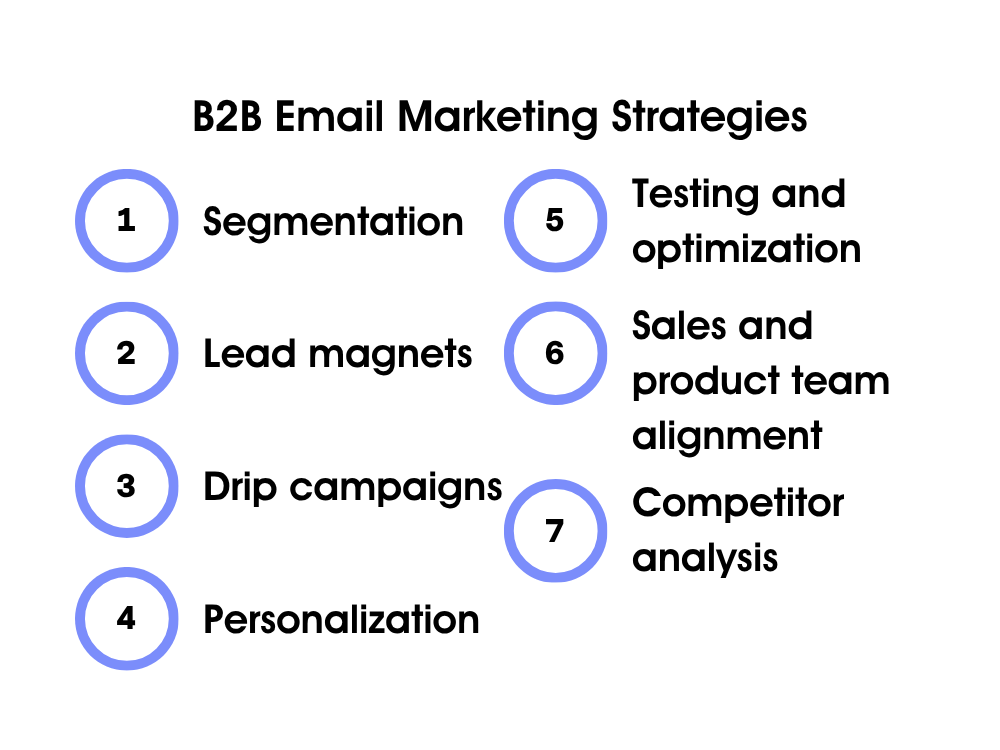
Here are key strategies to level up your B2B email marketing efforts:
1. Segment Your Audience for Relevance
One-size-fits-all emails rarely work in B2B. Your audience likely includes multiple personas—CEOs, marketers, IT professionals, procurement teams—each with different needs, pain points, and priorities.
What to do:
- Segment based on industry, job title, company size, buying stage, or behavior (e.g., downloaded a whitepaper, attended a webinar).
- Create different email tracks for new leads, engaged users, and dormant contacts.
Example:
A SaaS company selling project management software might send feature comparison guides to IT directors and ROI-focused case studies to CFOs.
2. Use Lead Magnets to Attract Qualified Contacts
Lead magnets are valuable resources you offer in exchange for contact information. In B2B, they should provide deep insights or solve a specific business problem.
Ideas for lead magnets:
- Whitepapers and research reports
- Case studies or success stories
- Free tools or calculators
- Webinars and workshops
- Industry-specific templates (e.g., proposal templates, budget planners)
Tip: Promote your lead magnets through social ads or landing pages and funnel the new leads into relevant automated email flows.
3. Build Drip Campaigns to Nurture Leads Over Time
Most B2B prospects aren’t ready to buy immediately. Drip campaigns—automated series of emails—let you stay top-of-mind and guide them toward a decision.
How to use drip campaigns:
- Welcome sequence: Introduce your brand, share core benefits, and guide the user to explore your product.
Post-download follow-up: After someone downloads a resource, follow up with related content or a CTA to book a demo. - Lead nurturing series: Gradually introduce features, customer stories, and relevant use cases tailored to the recipient’s role or industry.
Example:
After someone downloads a guide on “Improving Sales Pipeline Visibility,” your drip could share a relevant blog post, a short explainer video, and finally offer a 15-minute strategy call.
4. Personalize Beyond Just Using First Names
B2B buyers expect personalization—but it goes far beyond “Hi [First Name].” Personalization can happen at multiple levels:
- Behavioral personalization: Trigger emails based on actions like visiting a pricing page or watching a webinar.
Content personalization: Recommend resources or case studies based on industry, role, or company size.
Dynamic fields: Use CRM data to insert company names, pain points, or previous engagement history into your emails.
Example:
“Hi Sarah, we noticed your team at [Company] recently downloaded our marketing automation guide. Here’s how other agencies use our tool to cut campaign setup time in half.”
5. Test and Optimize Continuously
Treat every email as a learning opportunity. A/B test different elements—like subject lines, send times, CTAs, and layout formats—and apply the insights to future campaigns.
What to test:
- Plain text vs. HTML emails
- Short vs. long subject lines
- Button copy: “Get Started” vs. “Book My Demo”
- Content formats: e.g., videos, bullet-point lists, gifs
Use performance data (opens, clicks, conversions, unsubscribes) to refine your approach and find what resonates with each segment.
6. Align Email Strategy with Sales and Product Teams
In B2B, email is often a bridge between marketing and sales. Coordinate with your sales team to ensure your messaging supports their conversations, and use product team input to surface relevant updates or use cases.
Examples:
- Share “objection-busting” emails that address common sales concerns.
- Send product launch updates to prospects who previously requested similar features.
- Loop in sales reps via alerts or CRM notes when a contact shows high email engagement.
7. Monitor and Learn from Competitor Email Strategies
Keeping an eye on your competitors' email marketing can reveal a lot: how often they send, what CTAs they use, and which campaigns they’re pushing. This can help you spot content gaps, benchmark performance, and even inspire your own campaigns.
How to track competitors:
- Sign up for their newsletters with a monitoring inbox.
- Use tools like Panoramata to automatically track their email strategy over time
- Look for trends in their subject lines, offers, and design elements.
Example:
If a competitor is heavily promoting an integration you also offer, you might want to highlight your version with a stronger differentiator.
Best Practices for Designing a B2B Email Marketing Campaign
Design isn’t just about how your email looks—it’s also about how effectively it communicates. Follow these best practices to increase engagement and conversions:
Clear and Specific Subject Lines
Avoid vague subject lines like “Check this out.” Instead, use direct, benefit-driven headlines like:
- “How [Company] Increased B2B Leads by 45% in 3 Months”
- “Join Our Webinar: Future-Proof Your IT Stack in 2025”
One Goal Per Email
Each email should have one clear purpose—whether it’s signing up for a webinar, downloading a resource, or booking a call. Avoid overwhelming your audience with too many CTAs.
Responsive Design
B2B buyers check their inboxes on mobile too. Use responsive templates and test across devices to ensure readability.
Professional but Human Tone
Write like a real person talking to another real person. Use their name, personalize based on company or industry, and avoid jargon overload.
A/B Test Subject Lines and CTAs
What works for one segment might flop for another. Test different versions of your subject lines, button copy, and send times to optimize performance.
5 Examples of Great B2B Email Marketing Campaigns
Need inspiration? Here are a few examples of B2B emails done right:
Asana’s welcome email
Subject: Your Asana trial starts today
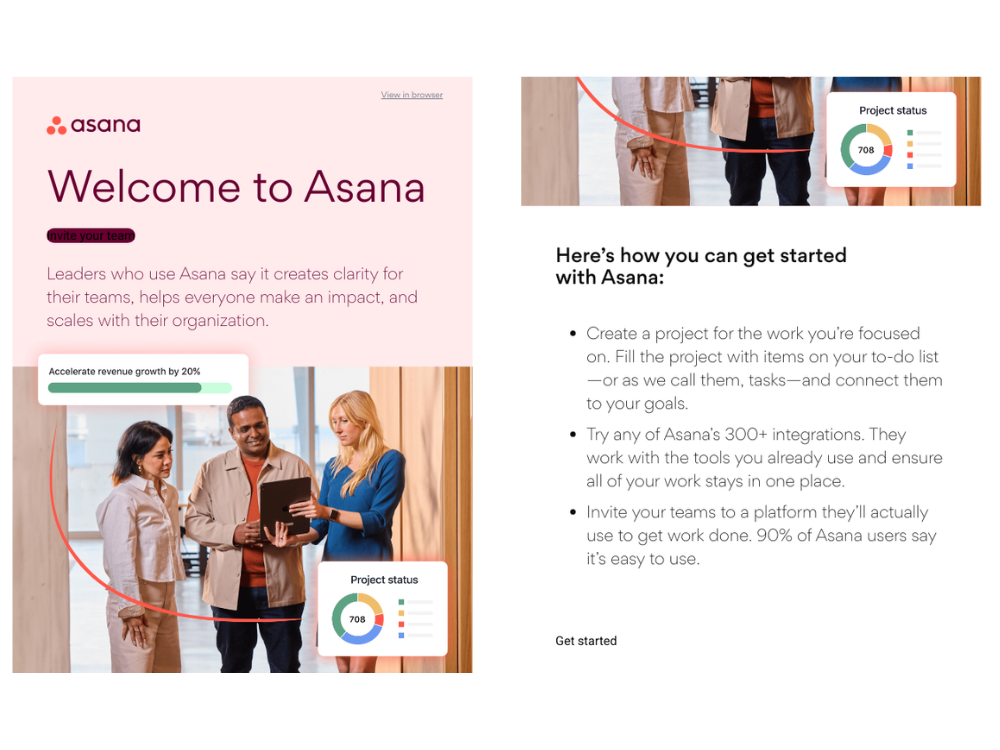
Asana’s first email after a customer signs up sets the tone for their relationship.
It paints a picture of what a user can achieve with the tools they provide and gives succinct suggestions on what to do next, ensuring that the new user knows the next steps to take to maximize their platform.
Figma’s release notes
Subject: New Figma releases, just for you

Figma’s product release email is interesting and matter-of-fact, using colors and illustrations to keep it interesting while still providing key information quickly.
The email doesn’t go into detail about each new feature but provides links for interested readers to learn more, thereby simplifying the email and avoiding clutter.
Hubspot’s informative newsletter
Subject: 🤖Tattlebot
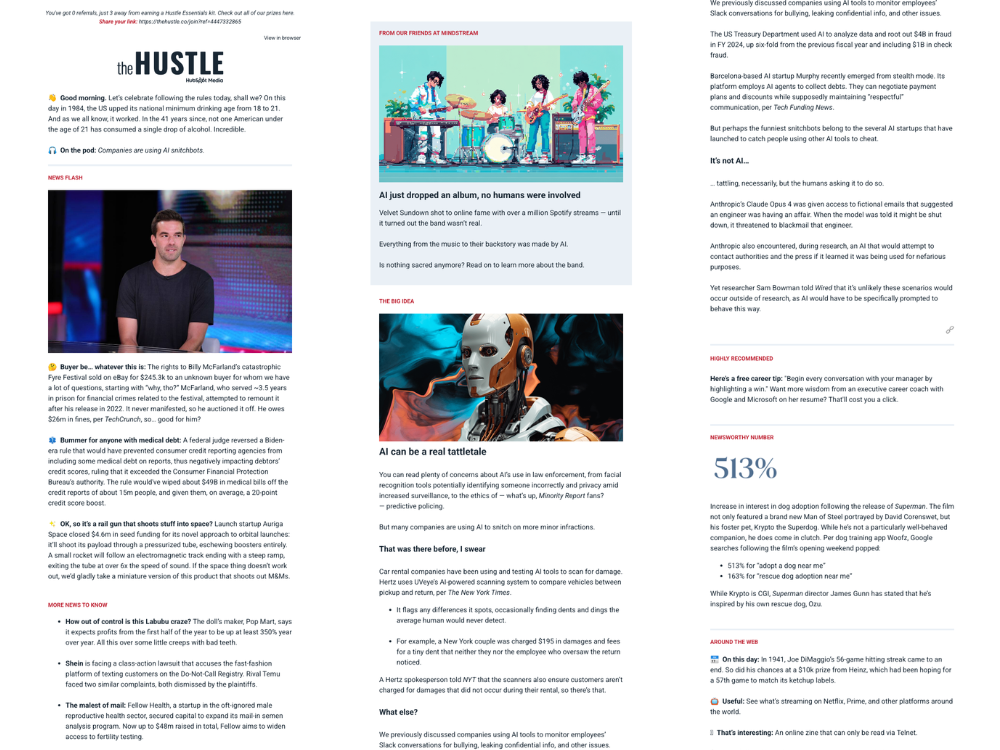
Hubspot regularly distributes a newsletter called The Hustle.
Unlike the previous B2B email examples, this one is lengthy but for a good reason. Its goal is ultimately to establish credibility and nurture their leads by providing high-quality information at a regular schedule.
They discuss the latest news and trends and give their opinion while refraining from sounding too serious by inserting little factoids, quotes, tips, and “shower thoughts”.
Klaviyo’s cross-promotional email
Subject: How did Smile Brilliant unlock 39x ROI with Klaviyo?
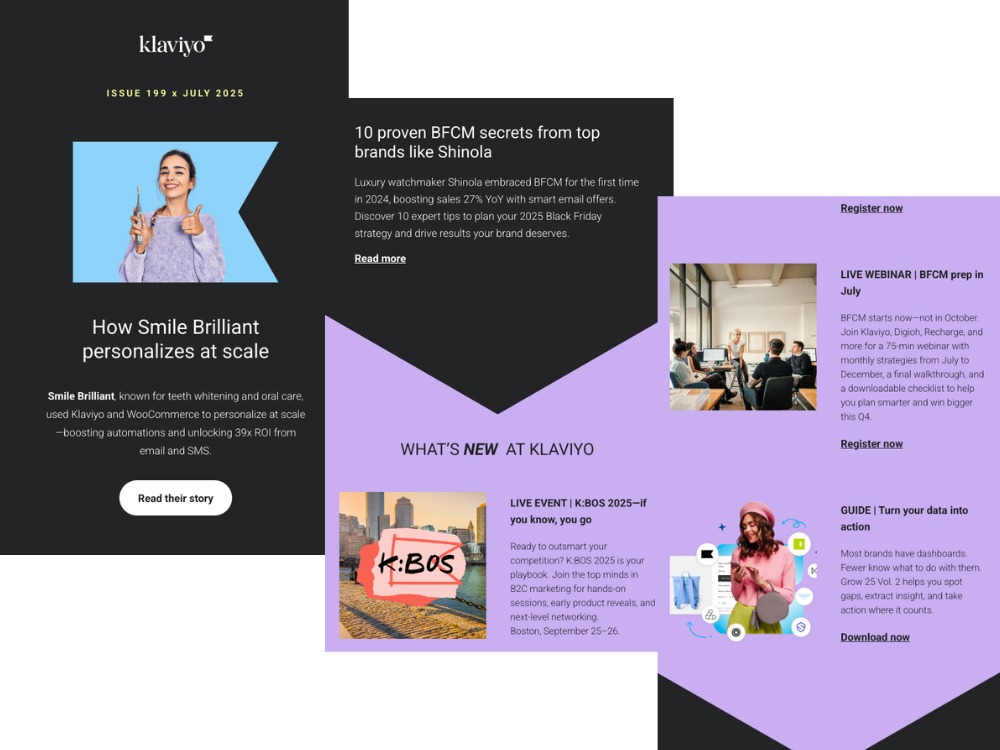
Klaviyo spotlights their other content using their email newsletter, a smart move if you want to drive your subscribers to your other channels, potentially increasing engagement and conversions.
In this email, they’re highlighting a case study featuring a client’s success story. The CTA leads to the full article on their website.
Sprout Social’s event invitation
Subject: [Invite] Midyear social recap

A webinar invite is a classic B2B email that’s proven to increase attendance and engagement. This invitation email goes straight to the important details of the event: date, time, speakers, and a link to register.
They also tease the reader by giving a preview of what to expect from the event without giving everything away.
Boost your B2B email marketing campaign’s performance
B2B email marketing is more than just newsletters and promotions. It’s a long-term strategy to engage decision-makers and boost your bottomline.
With smart segmentation, personalized messaging, and a focus on value, your email campaigns can become a powerful engine for leads and conversions.
And don’t forget—your competitors are likely emailing the same audience. Keeping an eye on their strategies (subject lines, timing, offers) can help you stay one step ahead.
Want email ideas and inspiration for your next campaign? Check out our email swipe file with over 100 newsletter ideas.
FAQs
What is the primary goal of B2B email marketing?
The main goals revolve around lead generation, building relationships, educating about products, and driving sales, focusing on nurturing long-term connections.
Why is audience segmentation important in B2B email marketing?
Segmentation allows you to tailor messages to different professional personas based on factors like industry, job title, and buying stage, making emails more relevant and effective.
What kind of content is effective in B2B emails?
Effective content includes product demos, webinar invites, industry reports, case studies, customer onboarding flows, and re-engagement campaigns for inactive leads.


